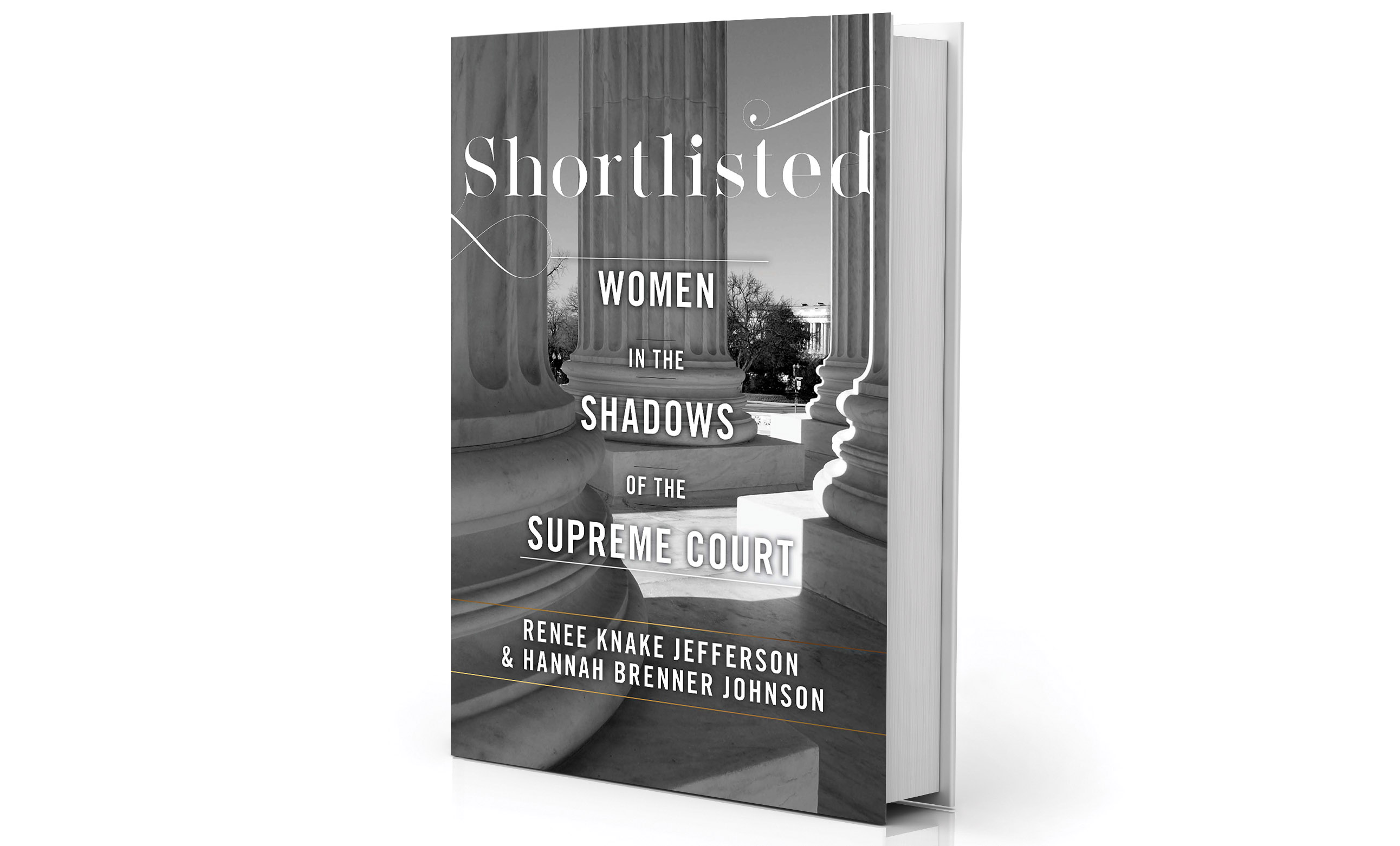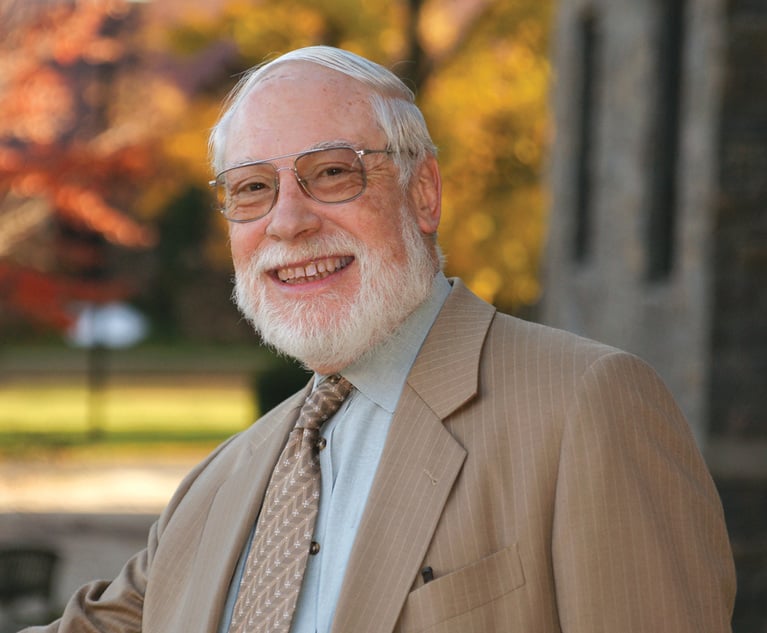'Shortlisting' as a Way to Maintain the Status Quo
In suggesting ways in which women can go from "shortlisted to selected," the book develops themes from the "lived experiences" to elucidate "strategies for counteracting the biases and prejudices that endure."
July 15, 2020 at 01:39 PM
8 minute read
 "" women="" in="" shadows="" of="" the="" supreme="" width="2584" height="1562" />
"" women="" in="" shadows="" of="" the="" supreme="" width="2584" height="1562" />
Book review: "Shortlisted: Women in the Shadows of the Supreme Court" by Renee Knake Jefferson and Hannah Brenner Johnson, New York University Press, 304 pages, $30
Two perverse strategies, "shortlisting" and "tokenism," have impeded the progress of women in the legal profession. In a new book by professors Renee Knake Jefferson and Hannah Brenner Johnson, the co-authors analyze how shortlisting and tokenism affected the lives and careers of nine women who were "considered" but not appointed to the U.S. Supreme Court. Through the "collective narrative" of these women, the book strives to "better understand and ultimately ameliorate the dynamics that perpetually keep women on the shortlist." As such, it is a useful book that not only exposes these strategies for what they are—instruments to preserve the status quo—but it also suggests meaningful ways in which to "surmount the shortlist."
The authors bring impressive credentials to their task. Jefferson is a law professor at the University of Houston who specializes in professional responsibility and gender issues. In the wake of the Larry Nasser sexual abuse scandal, she was appointed to the board of trustees of Michigan State University. In 2018, she also consulted with the Federal Judiciary Ethics Commission regarding the mistreatment of women. Johnson teaches law and serves as a vice dean at the California Western School of Law. Her academic pursuits have included gender-based violence and gender inequality. In 2019, the two professors also co-authored a casebook entitled "Gender, Power, Law & Leadership."
The nine shortlisted women who are featured in the book include seven judges, one law professor and a presidential cabinet secretary. They include: Judge Florence Allen of the Ohio Supreme Court and the U.S. Court of Appeals for the Sixth Circuit; professor Soia Mentschikoff of Harvard University and the University of Chicago; Judge Sylvia Bacon of the District of Columbia Superior Court; Judge Mildred Lillie of the California Court of Appeal; Judge Carla Hills (Housing and Urban Development secretary); Judge Cornelia Kennedy of the U.S. Court of Appeals for the Sixth Circuit; Judge Amalya Kearse of the U.S. Court of Appeals for the Second Circuit; Judge Joan Dempsey Klein of the California Court of Appeal; and Judge Susie Sharp of the North Carolina Supreme Court.
In addition, the book also discusses three women judges who were shortlisted after Sandra Day O'Connor became the first woman appointed to the Supreme Court in 1981: Judge Cynthia Holcomb-Hall of the U.S. Court of Appeals for the Ninth Circuit; Judge Pamela Rymer of the U.S. Court of Appeals for the Ninth Circuit; and Judge Edith Jones of the U.S. Court of Appeals for the Fifth Circuit.
The book presents a polished narrative. It is concise, devoid of jargon, well researched and accessible to lay readers. In addition to analyzing pertinent documentation from nine presidential libraries, the authors also examined collected papers from seven other archives, media reports from 15 periodicals and countless books, articles and oral histories. Impressively, the book contains 43 pages of appendices and notes, which amply support the 218-page narrative.
As chronicled by the authors, some presidents have shortlisted women as a political strategy. Even without selecting any of the women to fill Supreme Court vacancies, these presidents used shortlists to "check boxes" and "score political points," while not taking any of the women seriously.
This was especially true for President Richard Nixon. During his 1969-1974 tenure, Nixon appointed one chief justice (Warren Burger) and three associate justices (Harry Blackmun, Lewis Powell and William Rehnquist) to fill Supreme Court vacancies. According to the authors, in considering candidates for those vacancies, Nixon publicly shortlisted two women, Bacon and Lillie. However, Nixon never considered actually appointing them. Nixon told his first attorney general, John Mitchell, that: "I don't think a woman should be in any government job whatever." Nixon went even further with White House counsel John Dean, stating: "I don't think women should be allowed to vote even."
This attitude was reenforced by Burger, who wrote to Mitchell stating he was not anxious to have a woman on the Court. According to Dean, Burger threatened to resign if Nixon put a woman on the Court.
As noted in the book, in the 1970s the legal world was still run almost entirely by men who never had any peer experiences with women. Prior to President Jimmy Carter's term (1977-1981), only 10 women had ever been appointed to federal court judgeships. During Carter's tenure, however, he appointed 40 women to the federal bench, including Ruth Bader Ginsberg (to the U.S. Court of Appeals for the District of Columbia).
Although President Ronald Reagan (1981-1989) appointed O'Connor to be the first female justice on the Supreme Court, he appointed fewer women to the federal bench in eight years than Carter had appointed in only four years.
In Reagan's second term, Burger and Powell retired, thus providing the president with two additional appointments. As noted by the authors, in considering possible appointees, Reagan shortlisted three women, Holcomb-Hall, Rymer and Jones. Rather than build on the O'Connor appointment and eliminate her "token" status, however, Reagan instead chose white males to fill the vacant seats. The historical record indicates that Reagan did not intend to appoint any of these women, but by shortlisting them he "checked the gender box."
The authors make a convincing case that shortlists project a "façade of diversity with their inclusion of women and minorities, but function to preserve the status quo." In so doing, they adroitly point out that, in the hands of the decision-maker, shortlisting "is attributable to bias, discrimination, prejudice and the dominant group's desire to remain in control."
The book also argues that tokenism has impeded equality by promoting the perception that equality has been achieved based on the presence of a woman or a minority. As such, tokenism creates a misconception that reduces the urgency to diversify, imposes unfair burdens on the token, allows for the proliferation of sexual harassment and promotes the current power structure.
In suggesting ways in which women can go from "shortlisted to selected," the book develops themes from the "lived experiences" of the nine women to elucidate "strategies for counteracting the biases and prejudices that endure."
The first strategy involves "leveraging a legal education." A law degree offers "legitimacy and credibility," because it equips its holder with the skills "necessary to endure and move beyond prejudice and bias." It also provides an "important first step for women toward credentialing themselves for positions of leadership and power." As pointed out by the authors, about one-third of the women elected to Congress in 2018 had earned law degrees.
The authors also stress the importance of choosing friends and lovers who value women's professional lives. The nine women chronicled in the book tended to develop personal relationships with people who viewed them as equals, supported and celebrated their professional success and stayed invested in the bond even when the women ultimately outperformed or overshadowed them.
The authors also focus on collaboration and mentorship. The stories of the nine women "reveal how collaboration among women can make them more competitive, collectively, for positions of power."
Another strategy recommends that women create opportunities, and not simply wait for them. Although they had earned top law school grades, many of the nine women were rejected for private practice. Undeterred, many of them pursued early careers as prosecutors or served in other government posts. These public sector posts subsequently created opportunities that enabled the women to obtain positions of increased power and prestige.
The authors also believe in changing legal workplace cultures and increasing government support so that early child care is treated as a public good. This will not only enable women professionals to manage the work-life balance, but also decrease the frequency of having to choose between raising children and rising in a career.
Finally, the authors advocate the implementation of structural changes that do not burden women. For example, in 1977, Carter sought to diversify the federal judiciary. To promote that change, he issued an executive order establishing judicial nominating commissions, which were ordered to include women and minorities. Once convened, these commissions were urged to ask judicial candidates to explain how they had worked to further civil rights, women's rights and the rights of other disadvantaged groups. These changes spurred the first real diversification of the federal judiciary. In the words of Michelle Obama, "sameness breeds sameness, until you make a thoughtful effort to counteract it."
Jeffrey M. Winn is an attorney with the Chubb Insurance Group and is a vice chair of the committee on the judiciary of the New York City Bar Association.
This content has been archived. It is available through our partners, LexisNexis® and Bloomberg Law.
To view this content, please continue to their sites.
Not a Lexis Subscriber?
Subscribe Now
Not a Bloomberg Law Subscriber?
Subscribe Now
NOT FOR REPRINT
© 2025 ALM Global, LLC, All Rights Reserved. Request academic re-use from www.copyright.com. All other uses, submit a request to [email protected]. For more information visit Asset & Logo Licensing.
You Might Like
View All
Law Journal Column on Marital Residence Sales in Pending Divorces Puts 'Misplaced' Reliance on Two Cases
8 minute read

A Time for Action: Attorneys Must Answer MLK's Call to Defend Bar Associations and Stand for DEI Initiatives in 2025
5 minute readTrending Stories
- 1Thursday Newspaper
- 2Public Notices/Calendars
- 3Judicial Ethics Opinion 24-117
- 4Rejuvenation of a Sharp Employer Non-Compete Tool: Delaware Supreme Court Reinvigorates the Employee Choice Doctrine
- 5Mastering Litigation in New York’s Commercial Division Part V, Leave It to the Experts: Expert Discovery in the New York Commercial Division
Who Got The Work
J. Brugh Lower of Gibbons has entered an appearance for industrial equipment supplier Devco Corporation in a pending trademark infringement lawsuit. The suit, accusing the defendant of selling knock-off Graco products, was filed Dec. 18 in New Jersey District Court by Rivkin Radler on behalf of Graco Inc. and Graco Minnesota. The case, assigned to U.S. District Judge Zahid N. Quraishi, is 3:24-cv-11294, Graco Inc. et al v. Devco Corporation.
Who Got The Work
Rebecca Maller-Stein and Kent A. Yalowitz of Arnold & Porter Kaye Scholer have entered their appearances for Hanaco Venture Capital and its executives, Lior Prosor and David Frankel, in a pending securities lawsuit. The action, filed on Dec. 24 in New York Southern District Court by Zell, Aron & Co. on behalf of Goldeneye Advisors, accuses the defendants of negligently and fraudulently managing the plaintiff's $1 million investment. The case, assigned to U.S. District Judge Vernon S. Broderick, is 1:24-cv-09918, Goldeneye Advisors, LLC v. Hanaco Venture Capital, Ltd. et al.
Who Got The Work
Attorneys from A&O Shearman has stepped in as defense counsel for Toronto-Dominion Bank and other defendants in a pending securities class action. The suit, filed Dec. 11 in New York Southern District Court by Bleichmar Fonti & Auld, accuses the defendants of concealing the bank's 'pervasive' deficiencies in regards to its compliance with the Bank Secrecy Act and the quality of its anti-money laundering controls. The case, assigned to U.S. District Judge Arun Subramanian, is 1:24-cv-09445, Gonzalez v. The Toronto-Dominion Bank et al.
Who Got The Work
Crown Castle International, a Pennsylvania company providing shared communications infrastructure, has turned to Luke D. Wolf of Gordon Rees Scully Mansukhani to fend off a pending breach-of-contract lawsuit. The court action, filed Nov. 25 in Michigan Eastern District Court by Hooper Hathaway PC on behalf of The Town Residences LLC, accuses Crown Castle of failing to transfer approximately $30,000 in utility payments from T-Mobile in breach of a roof-top lease and assignment agreement. The case, assigned to U.S. District Judge Susan K. Declercq, is 2:24-cv-13131, The Town Residences LLC v. T-Mobile US, Inc. et al.
Who Got The Work
Wilfred P. Coronato and Daniel M. Schwartz of McCarter & English have stepped in as defense counsel to Electrolux Home Products Inc. in a pending product liability lawsuit. The court action, filed Nov. 26 in New York Eastern District Court by Poulos Lopiccolo PC and Nagel Rice LLP on behalf of David Stern, alleges that the defendant's refrigerators’ drawers and shelving repeatedly break and fall apart within months after purchase. The case, assigned to U.S. District Judge Joan M. Azrack, is 2:24-cv-08204, Stern v. Electrolux Home Products, Inc.
Featured Firms
Law Offices of Gary Martin Hays & Associates, P.C.
(470) 294-1674
Law Offices of Mark E. Salomone
(857) 444-6468
Smith & Hassler
(713) 739-1250







